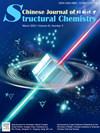回顾经典的[Fe4S4(SR)4]2 -分子簇:配体的空间效应及其结构转化
IF 10.3
4区 化学
Q1 CHEMISTRY, INORGANIC & NUCLEAR
引用次数: 0
摘要
具有立方[4Fe-4S]核的合成分子簇已经被研究了几十年,因为它们是生物系统中铁蛋白活性成分的真正类似物。这样的模型簇已经在各个领域进行了广泛的研究,包括结构调节、催化和实验室条件下的自组装,目的是深入了解它们在生物功能中的作用。在此,我们重新研究了三个已知的[Fe4S4(SR)4]2 -分子,即[Me4N]2[Fe4S4(SR)4] (R = o-MBT, m-MBT, p-MBT),并成功地建立了它们的单晶结构,这些结构在此之前一直是未知的。有趣的是,研究发现取代基甲基的位置对[4Fe-4S]核心周围配体的排列有明显的空间效应,进而影响它们在单晶中的整体排列方式。此外,本研究揭示了[Fe4S4(SR)4]2 -体系的两种新的结构转变行为:1)单体[Fe(SR)4]2 -和四聚体[Fe4S4(SR)4]2 -可以相互转化,2)[Fe4S4(SR)4]2 -可以在良好控制的氧化环境中转移到一个有趣的铁氧化物配合物na2fe60 (OMe)18·6MeOH中。本文章由计算机程序翻译,如有差异,请以英文原文为准。
![Revisit the classical [Fe4S4(SR)4]2– molecular clusters: The steric effects of ligands and their structural transformations](https://img.booksci.cn/booksciimg/2025-9/108322769251793772008.jpg)
Revisit the classical [Fe4S4(SR)4]2– molecular clusters: The steric effects of ligands and their structural transformations
The synthesized molecular clusters featuring the cubic [4Fe–4S] core have been studied for several decades, as they serve as true analogs of the active components in ferritin within biological systems. Such a model cluster has been extensively investigated in various fields, including structural modulation, catalysis, and self-assembly under laboratory conditions, with the aim of gaining an in-depth understanding of their roles in biological functions. Herein, we revisited three well-known [Fe4S4(SR)4]2– molecules, namely [Me4N]2[Fe4S4(SR)4] (R = o-MBT, m-MBT, p-MBT), and successfully established their single crystal structures that remain unknown prior to this work. Interestingly, it is revealed that the position of the substituent methyl group has an obvious steric effect on the arrangement of the ligand around the [4Fe–4S] core, which further influences their overall packing patterns in single crystals. In addition, this work unveils two new structure transformation behaviors for the [Fe4S4(SR)4]2– system: i) the monomeric [Fe(SR)4]2– and tetrameric [Fe4S4(SR)4]2– can be interconverted, and ii) [Fe4S4(SR)4]2– can be transferred into an intriguing iron-oxide complex Na2Fe6O(OMe)18·6MeOH in a well-controlled oxidizing environment.
求助全文
通过发布文献求助,成功后即可免费获取论文全文。
去求助
来源期刊

结构化学
化学-晶体学
CiteScore
4.70
自引率
22.70%
发文量
5334
审稿时长
13 days
期刊介绍:
Chinese Journal of Structural Chemistry “JIEGOU HUAXUE ”, an academic journal consisting of reviews, articles, communications and notes, provides a forum for the reporting and discussion of current novel research achievements in the fields of structural chemistry, crystallography, spectroscopy, quantum chemistry, pharmaceutical chemistry, biochemistry, material science, etc. Structural Chemistry has been indexed by SCI, CA, and some other prestigious publications.
 求助内容:
求助内容: 应助结果提醒方式:
应助结果提醒方式:


